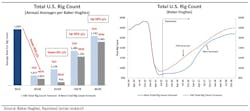US rig count down 8 units, ‘ugly’ next 12 months expected
After several weeks in which the overall US drilling rig count steadily climbed, the week ended Aug. 28 marked its largest loss since early June, dropping 8 units to 877 rigs working, according to data from Baker Hughes Inc.
The decline reflected a 9-unit drop in gas-directed rigs. The oil-directed count, however, increased for the sixth straight week, edging up a unit (OGJ Online, Aug. 21, 2015).
The overall count is now down 1,037 units year-over-year.
In its energy update this week, Raymond James & Associates Inc. noted that it has revised downward its 2015-16 forecast for crude oil prices and US exploration and production cash flows, reflected by what the financial services firm believes will be a “much slower” US drilling recovery than it previously anticipated.
RJA earlier in the year optimistically forecast the rig count would bottom out in June at 930 units, which ended up being 70 more than where the count actually settled. The firm now projects the count at yearend will total 891 units, down 117 from its previous estimate; and for the year average 1,013 units, a reduction of 58 rigs from its previous estimate.
RJA does “not expect a meaningful rebound in the total US rig count until the back half of 2016,” and believes “US oil field activity will remain roughly flat through the remainder of 2015 and early 2016.” For next year, RJA’s projected average count is 956 units, 220 lower compared with its previous forecast.
The firm, however, still sees a “surge” beginning in second-half 2016 and continuing through the following 2 years, with the count expected to average 1,391 units in 2017 and 1,643 units in 2018. In other words, the “next 12 months in US oil field activity should be ugly, but look for a robust recovery in 2017,” RJA said.
All but oil drops
This week’s movement has gas-directed rigs now totaling 202 while oil-directed rigs total 675. For oil-directed rigs, 47 units have come online since the week ended June 26 but the count is still down 900 year-over-year.
Land rigs fell 4 units to 843, down 995 year-over-year. Rigs engaged in horizontal drilling dropped 5 units to 672. Directional rigs gained 2 units to 80.
RJA notes that during the downturn, horizontal units have made up an increasing portion of the overall count, a trend that is expected to continue through the projected recovery.
“Already past the halfway point for the year, we are expecting horizontal rigs to make up 77% of the total rig count, or 8% more [year-over-year],” RJA said. “The steady shift toward more productive horizontal drilling that was already occurring in the market has been exacerbated by the rationalization of operator drilling programs. Vertical drilling programs have been the first to go as the total US rig count began to decline.
“We estimate that horizontal rigs will represent about 92% of the total rigs added from July 2015 through December 2017, representing 83% of active US rigs at the end of 2017,” the firm indicated.
This week, meanwhile, offshore units fell 2 units to 30. Eight units have gone offline over the past 3 weeks. Rigs drilling in inland waters also lost 2 units, settling at 4.
Canada’s rig count fell 12 units to 196, down 213 year-over-year. A bulk of this week’s losses came from oil-directed rigs, 9 of which were laid down to now total 88, down 143 year-over-year. Gas-directed rigs lost 3 units to 108.
Louisiana leads losses; Texas up again
Partially reflecting the decline in offshore rigs, Louisiana led the major oil- and gas-producing states this week with a 6-unit drop to 71, down 46 units year-over-year. New Mexico lost 2 units to 50. Oklahoma, Colorado, and Pennsylvania each edged down a unit to respective totals of 105, 36, and 35.
Pennsylvania has hit 6-year lows over the past few weeks. As with last week’s total, this week’s total is the state’s lowest since the week ended June 5, 2009.
Most of the states were unchanged from a week ago. Reporting the same totals were North Dakota at 72; Wyoming at 25; Ohio at 19; West Virginia at 17; Alaska, California, and Kansas each at 13; and Arkansas and Utah each at 4.
Texas, whose recent upward momentum was stymied last week, got back on track this week as the only state to report a gain. Its 3-unit rise put its total at 386, still down 514 year-over-year. Most movement in the major basins occurred in Texas, where the Permian increased 2 units to 255, while the Eagle Ford dropped 2 units to 97.
A report released this week by Wood Mackenzie, meanwhile, noted that while the number of producing wells in the Eagle Ford has fallen markedly during the downturn, the play is expected to produce 2 million b/d of oil and condensate by 2020, reflecting improved recoveries in core areas (OGJ Online, Aug. 26, 2015). Recently, the Eagle Ford has comprised a bulk of the output declines from major US shale plays (OGJ Online, Aug. 10, 2015).
RJA also sees growth in the play’s rig count as the decade advances. “We are also expecting the [overall US rig count] recovery to be led by the core plays, with the Permian, Eagle Ford, and Bakken seeing activity increase first,” the firm said.
“On an absolute basis, the Permian and Eagle Ford are expected to almost double through the end of 2017, growing 94% and 97%, respectively, while the Bakken is expected to grow 74%.” The firm expects the three plays to account for 55% of total rig additions over the same period, representing 384 of 697 units. The Permian alone will account for 31%, or 217 units.
Contact Matt Zborowski at [email protected].


